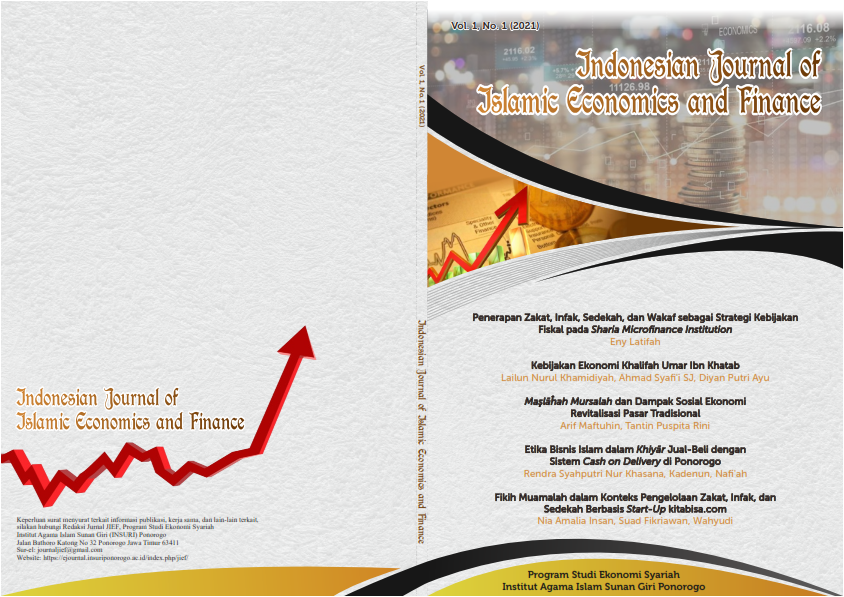The Influence of Innovation, Network, and Technology on Customer Switching to Bank Syariah Indonesia
DOI:
https://doi.org/10.37680/ijief.v4i2.5793Keywords:
Innovation; Network; SwitchingAbstract
This study analyzes the influence of product innovation, service quality, and office network on switching customer behavior from conventional banks to Bank Syariah Indonesia (BSI) in Selong District. This study uses a survey method with a quantitative approach, involving 100 BSI customer respondents who were taken by purposive sampling. Data were collected through questionnaires and analyzed using simple linear regression. The study results show that product innovation significantly influences customer switching behavior, with a contribution of 40.9%, followed by information technology by 18.6%. At the same time, the office network is not significant. These findings support the Planned Behavior theory and the Diffusion of Innovation theory, which states that innovations relevant to market needs can increase the adoption of sharia services. It is recommended that BSI strengthen its digital services and unique sharia features to attract more customers, increase competitiveness, and expand market share in the Islamic banking industry in Indonesia.
Downloads
References
Ahmad, F. (2021). Pengaruh Pelatihan Menulis terhadap Peningkatan Kualitas Karya Ilmiah. Pustaka Ilmiah.
Ajzen, I. (1991). The Theory of planned behavior. Organizational Behavior and Human Decision Processes. https://www.sciencedirect.com/science/article/pii/074959789190020T
Amin, H., Abdul-Rahman, A.-R., & Abdul-Razak, D. (2013). An integrative approach for understanding Islamic home financing adoption in Malaysia. International Journal of Bank Marketing, 31(7), 544–573.
Arnold, D., & Jeffery, P. (2016). The digital disruption of banking and payment services. In Research Handbook on Digital Transformations (pp. 103–120). Edward Elgar Publishing. https://www.elgaronline.com/edcollchap/edcoll/9781784717759/9781784717759.00012.xml
Bashir, S., & Hamid, H. (2019). Customer behavior in Islamic digital banking services. Journal of Islamic Marketing, 10(1), 347–363. https://doi.org/10.1108/JIMA-08-2017-0089
Brookfield, S. (2016). Memahami dan Memfasilitasi Pembelajaran Dewasa: Analisis Komprehensif Prinsip dan Praktik Efektif (Terjemahan). PT Remaja Rosdakarya.
Burnham, T. A., Frels, J. K., & Mahajan, V. (2003). Consumer Switching Costs: A Typology, Antecedents, and Consequences. Journal of the Academy of Marketing Science, 31(2), 109–126. https://doi.org/10.1177/0092070302250897
Clemes, M. D., Gan, C., & Zheng, L. Y. (2007). Customer switching behaviour in the New Zealand banking industry. Banks & Bank Systems, 2, Iss. 4, 50–65.
Creswell, J. W. (2016). Research Design: Pendekatan Metode Kualitatif,. Kuantitatif dan Campuran. Pustaka Pelajar.
Davis, F. D. (1989). Perceived usefulness, perceived ease of use, and user acceptance of information technology. MIS Quarterly, 319–340.
Gait, A., & Worthington, A. (2008). An empirical survey of individual consumer, business firm and financial institution attitudes towards Islamic methods of finance. International Journal of Social Economics, 35(11), 783–808.
Ghose, A., & Han, S. P. (2011). An empirical analysis of user content generation and usage behavior on the mobile Internet. Management Science, 57(9), 1671–1691. https://doi.org/10.1287/mnsc.1110.1375
Gujarati, D. N. (2002). Basic Econometrics 4th ed. http://dspace.kottakkalfarookcollege.edu.in:8001/jspui/bitstream/123456789/3846/1/Basic%20Econometrics%20(%20PDFDrive%20).pdf
Harahap, D. A. (2022). Menilik Transformasi Transaksi Elektronik di Perbankan.
Haron, H., Kassim, N., & Shamsuddin, S. (2018). Integrated service quality and customer switching in Islamic banks. International Journal of Islamic and Middle Eastern Finance and Management, 12(4), 476–492. https://doi.org/10.1108/IMEFM-03-2019-0097
Ismail, M., & Moghavvemi, S. (2018). The impact of innovation and digital transformation on customer behavior in Islamic banks. Journal of Islamic Marketing, 9(2), 196–210. https://doi.org/10.1108/JIMA-09-2016-0072
Jibril, S. M. (2019). Influence of product innovation on consumer switching behavior in the Nigerian banking sector. Journal of Islamic Marketing, 10(3), 822–835. https://doi.org/10.1108/JIMA-12-2016-0100
Karimi, J., & Walter, Z. (2015). The Role of Dynamic Capabilities in Responding to Digital Disruption: A Factor-Based Study of the Newspaper Industry. Journal of Management Information Systems, 32(1), 39–81. https://doi.org/10.1080/07421222.2015.1029380
Katterbauer, K., Syed, H., Cleenewerck, L., & Genc, S. Y. (2024). Islamic finance in the metaverse: Meta-finance frameworks for supporting the growth of Shariah-compliant finance options in the metaspace. In Islamic Finance in the Digital Age (pp. 301–314). Edward Elgar Publishing. https://www.elgaronline.com/edcollchap/book/9781035322954/book-part-9781035322954-27.xml
Khan, H., Hameed, M., & Sheikh, F. (2020). Determinants of customer switching behavior in Pakistan’s Islamic banking sector. International Journal of Islamic Marketing, 12(5), 342–360. https://doi.org/10.1108/JIMA-11-2019-0225
Khan, M. M., & Bhatti, M. I. (2008). Islamic banking and finance: On its way to globalization. Managerial Finance, 34(10), 708–725.
Khattak, N. A. (2010). Customer satisfaction and awareness of Islamic banking system in Pakistan. African Journal of Business Management, 4(5), 662.
Kindangen, R. S., Saerang, D. P., & Budiarso, N. S. (2022). Pengaruh Kompetensi, Motivasi dan Kompensasi Terhadap Kinerja Aparatur Pemerintah Desa Dalam Pengelolaan Keuangan Desa Berbasis Siskeudes di Kecamatan Remboken Kabupaten Minahasa. JURNAL RISET AKUNTANSI DAN AUDITING" GOODWILL", 13(2), 164–178.
Kotler, P., Keller, K. L., Brady, M., Goodman, M., & Hansen, T. (2016). Marketing Management 3rd edn PDF eBook. Pearson Higher Ed.
Mohamad, M. H., & Kassim, N. M. (2018). Role of information technology in Islamic banking: A case study of Malaysia. Journal of Islamic Accounting and Business Research, 9(1), 73–85. https://doi.org/10.1108/JIABR-05-2016-005
Neuman, W. L. (2014). Social research methods: Pearson new international edition: Qualitative and quantitative approaches (7th, Pearson new international ed.). GB: Pearson Education.
Omar, H., Abdul, A., & Rahim, S. (2021). Digital banking and customer satisfaction: A shift from traditional branches to digital platforms in Islamic banks. Journal of Islamic Banking and Finance, 15(3), 234–245. https://doi.org/10.1108/JIBF-11-2020-0041
Otoritas Jasa Keuangan. (2020). Statistik Perbankan Syariah.
Pursetyaningsih, D. (2008). Faktor-Faktor yang Mempengaruhi Perilaku Berpindah Nasabah di Bank. Jurnal Manajemen & Bisnis, 7(1), 45–56.
Rogers, E. M. (2003). Diffusion of innovations, 5th edn London. UK: Free Press.[Google Scholar].
Siagian, D. (2000). Metode statistika untuk bisnis dan ekonomi. Gramedia Pustaka Utama. https://books.google.com/books?hl=id&lr=&id=saZED8D4mpsC&oi=fnd&pg=PR9&dq=Siagian,+D.+dan+S.+(2006).+Metode+Statistika+untuk+Bisnis+dan+Ekonomi.+Gramedia+Pustaka+Utama.&ots=QQKsvPdyJK&sig=9JGpYhBL-9-cV2Oj5kDpUEmR3MI
Skog, D. A., Wimelius, H., & Sandberg, J. (2018). Digital Disruption. Business & Information Systems Engineering, 60(5), 431–437. https://doi.org/10.1007/s12599-018-0550-4
Statistik, B. P. (2021). Statistik Kecamatan Selong 2021. Badan Pusat Statistik Kabupaten Lombok Timur.
Sugiyono. (2006). Metode Penelitian Bisnis. Alfabeta.
Sugiyono. (2017). Metode Penelitian Kuantitatif, Kualitatif, dan R&D. Alfabeta.
Sugiyono. (2023). Metode Penelitian Pendidikan: Pendekatan Kuantitatif, Kualitatif, dan R&D. Alfabeta.
Sugiyono, D. (2013). Metode penelitian pendidikan pendekatan kuantitatif, kualitatif dan R&D. https://digilib.unigres.ac.id/index.php?p=show_detail&id=43
Sugiyono, P. P. (2016). Metode Penelitian Kunatitatif Kualitatif dan R&D. Alfabeta, Bandung. https://www.researchgate.net/profile/Hery-Purnomo/publication/377469385_METODE_PENELITIAN_KUANTITATIF_KUALITATIF_DAN_RD/links/65a89006bf5b00662e196dde/METODE-PENELITIAN-KUANTITATIF-KUALITATIF-DAN-R-D.pdf
Yusof, A., Rafi, M., & Sulaiman, S. (2020). The influence of service quality and digitalization on customer loyalty in Islamic banking. Journal of Islamic Marketing, 11(3), 521–534. https://doi.org/10.1108/JIMA-09-2018-0172
Zeithaml, V. A., Jaworski, B. J., Kohli, A. K., Tuli, K. R., Ulaga, W., & Zaltman, G. (2020). A Theories-in-Use Approach to Building Marketing Theory. Journal of Marketing, 84(1), 32–51. https://doi.org/10.1177/0022242919888477
Downloads
Published
How to Cite
Issue
Section
License
Copyright:
An author who publishes in Indonesian Journal of Islamic Ekonomics and Finance agrees to the following terms:
- Author retains the copyright and grants the journal the right of first publication of the work simultaneously licensed under a Creative Commons Attribution-NonCommercial 4.0 International License that allows others to share the work with an acknowledgment of the work's authorship and initial publication in this journal.
- Author is able to enter into separate, additional contractual arrangements for the non-exclusive distribution of the journal's published version of the work (e.g., post it to an institutional repository or publish it in a book) with the acknowledgment of its initial publication in this journal.
- Author is permitted and encouraged to post his/her work online (e.g., in institutional repositories or on their website) prior to and during the submission process, as it can lead to productive exchanges, as well as earlier and greater citation of the published work (See The Effect of Open Access).
License:
-
Attribution — You must give appropriate credit, provide a link to the license, and indicate if changes were made. You may do so in any reasonable manner, but not in any way that suggests the licensor endorses you or your use.
-
NonCommercial — You may not use the material for commercial purposes.
-
No additional restrictions — You may not apply legal terms or technological measures that legally restrict others from doing anything the license permits.
You are free to:
- Share — copy and redistribute the material in any medium or format
- Adapt — remix, transform, and build upon the material

This work is licensed under a Creative Commons Attribution-NonCommercial 4.0 International License.



.png)







